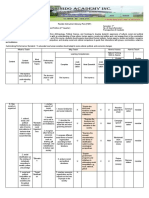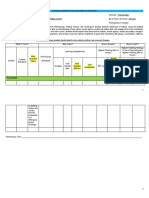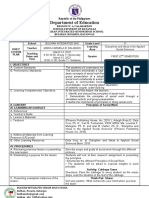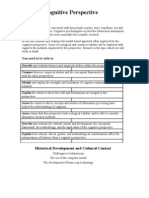0 ratings0% found this document useful (0 votes)
157 viewsGroup 6 (Cidam)
Group 6 (Cidam)
Uploaded by
nhfdbhddhsdeyterhguyThis course aims to develop students' understanding of cultural, social, and political dynamics and sensitivity to diversity. Students will learn about human cultures, agency, society, and politics. They will recognize cultural relativism and develop social competence. The culminating task challenges students to advocate how societies should adapt to changes. The performance task asks students to create an informational pamphlet for a community workshop addressing cultural interactions and differences among groups in their barangay. The pamphlet should reflect social issues and be understandable to all.
Copyright:
© All Rights Reserved
Available Formats
Download as DOCX, PDF, TXT or read online from Scribd
Group 6 (Cidam)
Group 6 (Cidam)
Uploaded by
nhfdbhddhsdeyterhguy0 ratings0% found this document useful (0 votes)
157 views5 pagesThis course aims to develop students' understanding of cultural, social, and political dynamics and sensitivity to diversity. Students will learn about human cultures, agency, society, and politics. They will recognize cultural relativism and develop social competence. The culminating task challenges students to advocate how societies should adapt to changes. The performance task asks students to create an informational pamphlet for a community workshop addressing cultural interactions and differences among groups in their barangay. The pamphlet should reflect social issues and be understandable to all.
Original Description:
kgkkgkfgkfjfuidgijoidjofomo ojgoijiojid
Copyright
© © All Rights Reserved
Available Formats
DOCX, PDF, TXT or read online from Scribd
Share this document
Did you find this document useful?
Is this content inappropriate?
This course aims to develop students' understanding of cultural, social, and political dynamics and sensitivity to diversity. Students will learn about human cultures, agency, society, and politics. They will recognize cultural relativism and develop social competence. The culminating task challenges students to advocate how societies should adapt to changes. The performance task asks students to create an informational pamphlet for a community workshop addressing cultural interactions and differences among groups in their barangay. The pamphlet should reflect social issues and be understandable to all.
Copyright:
© All Rights Reserved
Available Formats
Download as DOCX, PDF, TXT or read online from Scribd
Download as docx, pdf, or txt
0 ratings0% found this document useful (0 votes)
157 views5 pagesGroup 6 (Cidam)
Group 6 (Cidam)
Uploaded by
nhfdbhddhsdeyterhguyThis course aims to develop students' understanding of cultural, social, and political dynamics and sensitivity to diversity. Students will learn about human cultures, agency, society, and politics. They will recognize cultural relativism and develop social competence. The culminating task challenges students to advocate how societies should adapt to changes. The performance task asks students to create an informational pamphlet for a community workshop addressing cultural interactions and differences among groups in their barangay. The pamphlet should reflect social issues and be understandable to all.
Copyright:
© All Rights Reserved
Available Formats
Download as DOCX, PDF, TXT or read online from Scribd
Download as docx, pdf, or txt
You are on page 1of 5
CLASSROOM INSTRUCTION DELIVERY ALIGNMENT MAP (CIDAM)
Grade: 11/12 Semester: 1st/2nd
Course Subject Title: Understanding Culture, Society and Politics No. of Hours/Semester: 80
Course Subject Description: This course uses insights from Anthropology, Political Science, and Sociology to develop students’ awareness of cultural, social and political dynamics, and sensitivity to cultural diversity;
provide them with an understanding of how culture, human agency, society and politics work; and engage them in the examination of the country’s current human development goals. At the end of the course,
students should acquire ideas about human cultures, human agency, society and politics; recognize cultural relativism and social inclusiveness to overcome prejudices; and develop social and cultural competence to
guide their interactions with groups, communities, networks, and institutions.
Culminating Performance Standard: To advocate how human societies should adapt to such changes
Performance Task:
You observe that there are so many conflicts and problems brought by cultural differences in your respective barangay (Situation). As one of the social worker in your barangay (Role), you are tasked to do a
seminar- workshop (Goal) which tackles cultural interactions, differences and similarities among different groups and institutions as well as the barangay officials in your community (Audience). In line with this you
have to come up with a dissemination information material (Pamphlet, infomercial etc.) as an output of the seminar you are conducting to be read and disseminated to the attendees (Product). The dissemination
information material should reflect the diverse social concerns and issues among the community. Aligned to that, the dissemination information material should be well understood by all and thus have a remarkable
impact to the community. (Standard)
SECOND QUARTER
Re- Highest Enabling Strategy to Use in
Content Content Standard Performance Standard Learning Competencies grou Highest Thinking Level to Assess developing the Highest Thinking
ped Skill to Assess
K-U-D Com Assessment Technique
Enabling General Teaching
Classificati peten RBT Level
WW QA PC Strategy Strategy
on cies
E. How society is
Cultural, social, and
organized
political institutions as 1. Analyze aspects of social
1. Groups within society: TDAR Activity
sets of norms and organization 1. Traces
Primary and Secondary Observation (Think, Discuss,
patterns of behavior that kinship ties and U Analyzing Essay Communication
2. In-groups and out- Checklist Act, Reflect)
relate to major social 2. Identify one’s role in social social networks
groups Think Pair Share
interests groups and institutions
3. Reference groups
4. Networks
F. Cultural, social and 1. Cultural, social, and 1. Analyze aspects of social 1. Traces U Understanding
political institutions political institutions as organization kinship ties and
1. Kinship, marriage, and sets of norms and social networks
the household patterns of behavior that 2. Identify one’s role in social Genealogy
a. Kinship by blood relate to major social groups and institutions 2. Describe the mapping
Descent and marriage interests organized U Understanding Genealogy Representation Group Sharing
(unilineal, matrilineal, 3. Recognize other forms of nature of social Role Playing
patrilineal, bilateral) 2. Social stratification as economic transaction such life and rules
b. Kinship by marriage the ranking of individuals as sharing, gift exchange, governing
Marriage rules cross- according to wealth, and redistribution in his/her behavior
culturally power, and prestige own society U Analyzing
(monogamy vs. 3. Social and political 3. Compare
polygamy, post-marital inequalities as features of different social
residency rules, referred societies and the global forms of social
marriage community organization
1partners) according to
c. Kinship by ritual their manifest
(Compadrazgo) and latent
d. Family and the functions U Analysis
household
Nuclear, extended, and 4. Analyze
reconstituted social and
families (separated, political
transnational) structures
e. Politics of kinship
(political dynasty,
alliances)
2. Political and
leadership structures
a. Political organization
i. Bands
ii. Tribes 4. Analyze Graphic
Journal
iii. Chiefdoms social and Organizer
U Analysis Review Communication
iv. States and nations political Group Sharing
Essay
b. Authority and structures
legitimacy
i. Traditional
ii. Charismatic
iii. Rational
3. Economic 5. Analyze
Institutions economic
Complex
a. Reciprocity organization and
Diagram
b. Transfers its impacts on U Understanding Venn DIagram Representation
Game of
c. Redistribution the lives of
Charades
d. Market transactions people in the
e. Markets and state society
4. Nonstate institutions
AICDR Activity
a. Banks and
6. Differentiate (ASK,
corporations
functions of non- Self - Reasoning and INVESTIGATE,
b. Cooperatives and U Analysis Essay
state institutions Reflection Proof CREATE,
trade unions
in society DISCUSS,
c. Transnational
REJECT)
advocacy groups
d. Development agencies
e. International
organizations
5. Education a. Functions 7. evaluate how D Creating Essay Advocacy Problem Solving The 4 As Activity
of education in society functions of Campaign - Activity
(formal and nonformal) education affect (build on
the lives of students ideas)
people in - Analysis (Make
society thinking visible)
- Abstraction
(Encourage
listening to
others)
- Application
(Promote
autonomy/
lifelong learning)
6. Religion and belief 8. Promote
systems primary
a. Animism D
education as a
b. Polytheism human right
c. Monotheism
d. Institutionalized 9. Conduct
religions participant
e. Separation of church observation
and state (e.g., attend,
T-Chart
describe, and Triad Discussion
Positive and
reflect on a D Creating Problem Solving
Negative
religious ritual of Videoclip
Impact
a different
group; observe
elections
practices)
7. Health
a. Culture-specific 10. Recognize
syndromes and illnesses the practice of
(e.g., “bughat”, medical
Reflective
”usog”/”buyag”) pluralism in light Understanding Representation
Essay
b. Systems of diagnosis, of cultural
prevention and healing diversity and
(e.g., traditional, western, relativism
alternative healing
systems)
c. Health as a human
right
G. Social and political
stratification
a. Social desirables
(wealth, power, prestige) 1. Examine
b. Social mobility system stratisfaction
i. Open (Class) from the
1. Analyze aspects of
ii. Closed (Caste) functionalist
social organization
c. Social inequality and conflict
2. Identify one’s role in
i. Access to social, perspective
social groups and
political, and Social and political 2. Identify
institutions Scenario
symbolic capital inequalities as features of characteristi Analytical Reasoning and
3. Recognize other forms of U Evaluating Analysis/Video
ii. Gender inequality societies and the global cs of the Essay Proof
economic transactions Critiquing
iii. iii. Ethnic minorities community systems o
such as sharing, gift
iv. Other minorities stratisfaction
exchange and
(e.g., persons with 3. Suggest
redistribution in his or
disabilities) ways to
her own society
v. Global Inequality address
(relationships global
between states and inequalities
nonstate actors in
the global
community)
H. Cultural, Social, and
Political Change
Sources of social,
Brainstorming
cultural, and political
1. Identify new Watching
change
1. Evaluates factors challenges Documentary
1. Innovation
Social and political causing social, political, faced by Film
2. Diffusion
inequalities as features of and cultural change human Reflection Reasoning and Article
3. Acculturation and U Analyzing
societies and the global 2. Advocate how human populations Paper Proof Reading
assimilation
community societies should adapt to in Newscasting
4. Social contradictions
such changes contemporar Newspaper
and tensions (e.g., Inter-
y societies Scavenger
ethnic conflicts, class
Technique
struggle, armed conflict,
terrorism, protests,
gender issues)
I. New challenges to The agents/ institutions, 1. Evaluates factors Describe how Research Ess Site Visits
D Analyzing Problem Solving
human adaptation and processes, and causing social, political, human societies Presentation ay
social change outcomes of cultural, and cultural change adapt to new Timeline
1. Global warming and political, and social challenges in
climate change 2. change the physical, Problem
Transnational migration social, and Solution Chart
and Overseas Filipino cultural
Workers (OFWs) environment
J. Responding to
social, political, and Article
cultural change The learners Reading
1. Inclusive Citizenship demonstrate and Develop a plan Identifying
and participatory understanding of the 1. Advocate how human of action for different Dissemination Video Analyis
Ess
governance agents/institutions, societies should adapt to community- D Creating factors Information Problem Solving Collaborating
ay
2. New forms of media processes and outcomes such changes based response causing social Material ideas
and social networking of cultural, political, and to change political and
3. Social movements social change cultural
(e.g., environmentalism, change
feminism)
You might also like
- What Does Implicit Processes Mean in Counselling - Google SearchDocument1 pageWhat Does Implicit Processes Mean in Counselling - Google Searchjoannepollard741No ratings yet
- Psychological Coping Skills For AthletesDocument3 pagesPsychological Coping Skills For AthletesTeresa Prendes100% (1)
- Hands-On Social Studies for Ontario, Grade 2: An Inquiry ApproachFrom EverandHands-On Social Studies for Ontario, Grade 2: An Inquiry ApproachNo ratings yet
- FIDP DIASS 1st and 2nd QuarterDocument9 pagesFIDP DIASS 1st and 2nd QuarterBenjie Villaflores100% (7)
- Fidp - Understanding Culture Society and PoliticsDocument7 pagesFidp - Understanding Culture Society and PoliticsChristian Mark Almagro Ayala89% (18)
- Flexible Instruction Delivery Plan (FIDP) : Pura Academy IncDocument4 pagesFlexible Instruction Delivery Plan (FIDP) : Pura Academy IncBernadette Reyes75% (8)
- Cidam - g11 Ucsp 1st QuarterDocument7 pagesCidam - g11 Ucsp 1st Quarterjessica navajaNo ratings yet
- Organizational Behaviour JohnsSaks PDFDocument596 pagesOrganizational Behaviour JohnsSaks PDFElenaBeatriceBleza50% (2)
- Social Psychology 4th Edition Test BankDocument9 pagesSocial Psychology 4th Edition Test BanktestbanklooNo ratings yet
- ACID PlanDocument2 pagesACID PlanKhy Nellas-LeonorNo ratings yet
- Ucsp Q2 LP Sy 2019 2020Document22 pagesUcsp Q2 LP Sy 2019 2020Bernadette ReyesNo ratings yet
- Template For CIDAMDocument3 pagesTemplate For CIDAMLowrence TobiasNo ratings yet
- Template For CIDAMDocument3 pagesTemplate For CIDAMLowrence Tobias100% (1)
- The Learners Demonstrate An Understanding Of: The Learners Shall Be Able To: The Learners: The LearnersDocument4 pagesThe Learners Demonstrate An Understanding Of: The Learners Shall Be Able To: The Learners: The LearnersKISHANo ratings yet
- Flexible Instruction Delivery Plan (FIDP) - For SHSDocument6 pagesFlexible Instruction Delivery Plan (FIDP) - For SHSVon bhrianeNo ratings yet
- How Individu Als Learn Culture and 1. Identify Norms and Values To Be 1. Explain The Developm Ent of One's Self andDocument3 pagesHow Individu Als Learn Culture and 1. Identify Norms and Values To Be 1. Explain The Developm Ent of One's Self andCristy GallardoNo ratings yet
- DocumentDocument7 pagesDocumentSheila Mae PusingNo ratings yet
- Performance Task: Action Plan of A Certain Social IssueDocument4 pagesPerformance Task: Action Plan of A Certain Social IssueCristy GallardoNo ratings yet
- Acid Plan (Diss)Document4 pagesAcid Plan (Diss)Lea MasilunganNo ratings yet
- Diss CidamDocument3 pagesDiss Cidamgladys ambito0% (1)
- Fidp - UcspDocument3 pagesFidp - Ucspgenesisgamaliel montecino75% (8)
- Araño Template FIDPDocument4 pagesAraño Template FIDPMark Vincent DoriaNo ratings yet
- Fidp UcspDocument3 pagesFidp UcspIn SanityNo ratings yet
- FIDP For PassDocument3 pagesFIDP For Passmarlon anzanoNo ratings yet
- Fidp 3 A NewDocument3 pagesFidp 3 A NewJessevel Sabanal CalledoNo ratings yet
- The Learners Demonstr Ate An Understan Ding of The Learners Shall Be Able To The LearnersDocument6 pagesThe Learners Demonstr Ate An Understan Ding of The Learners Shall Be Able To The LearnersJhazz PerezNo ratings yet
- Flexible Instruction Delivery PlanDocument2 pagesFlexible Instruction Delivery PlanAbunaim Oraco MacapadoNo ratings yet
- Fidp Diass IbabaoDocument10 pagesFidp Diass IbabaoNikki Anne BerlanasNo ratings yet
- Inquiry-Based Instructio NDocument5 pagesInquiry-Based Instructio NPercival AlvarezNo ratings yet
- Understanding Culture Society and Politics Flexible Instructional Delivery PlanDocument2 pagesUnderstanding Culture Society and Politics Flexible Instructional Delivery PlanChristian Mark Almagro Ayala67% (3)
- 1ST Sem - Fidp (WK1) - Empowerment11 - EditedDocument2 pages1ST Sem - Fidp (WK1) - Empowerment11 - EditedMarielle AlystraNo ratings yet
- Flexible Instruction Delivery Plan (Fidp)Document2 pagesFlexible Instruction Delivery Plan (Fidp)Melissa Ann BuhianNo ratings yet
- Cidam Understanding Culture Society and PoliticsDocument4 pagesCidam Understanding Culture Society and PoliticsDarwin RonquilloNo ratings yet
- Social Environment and Social WorkDocument9 pagesSocial Environment and Social WorkVeluz, Luisa Angela A.No ratings yet
- Cidam - Ucs First SemDocument5 pagesCidam - Ucs First SemJoyce Lee De GuzmanNo ratings yet
- Curriculum Map in UCSP 1Document6 pagesCurriculum Map in UCSP 1JOSHUA REYESNo ratings yet
- Blessed Christian School de Santa Rosa - Inc: The Learners Should Be Able ToDocument6 pagesBlessed Christian School de Santa Rosa - Inc: The Learners Should Be Able ToAngelyn LingatongNo ratings yet
- Why Teach? How To Assess?: Critical & Problem SolvingDocument3 pagesWhy Teach? How To Assess?: Critical & Problem Solvingmarlon anzanoNo ratings yet
- Community Engagement Solidarity and Citizenship Curriculum GuideDocument8 pagesCommunity Engagement Solidarity and Citizenship Curriculum GuideJean Rose GentizonNo ratings yet
- Q2 - Understanding Curriculum MapDocument6 pagesQ2 - Understanding Curriculum MapWillisNo ratings yet
- OBE - Mantilla, Kris - 070824 v2Document19 pagesOBE - Mantilla, Kris - 070824 v2KrisNo ratings yet
- Community Engagement Solidarity and Citizenship Curriculum GuideDocument8 pagesCommunity Engagement Solidarity and Citizenship Curriculum GuideAkieyah KinichieNo ratings yet
- Cdam - Corsoc 02 UnderstandingDocument16 pagesCdam - Corsoc 02 UnderstandingMarra Kathleen AyaayNo ratings yet
- Flexible Instruction Delivery Plan (FIDP) : What To Teach?Document4 pagesFlexible Instruction Delivery Plan (FIDP) : What To Teach?Julie Ann EstradaNo ratings yet
- Flexible Assessme NT Activities (FAA) Enabling General Strategy Flexible Learning Strategies (FLS) Performan Ce Check(s)Document4 pagesFlexible Assessme NT Activities (FAA) Enabling General Strategy Flexible Learning Strategies (FLS) Performan Ce Check(s)Kristann Manalo100% (2)
- Fidp Understanding Culture Society and PoliticsDocument7 pagesFidp Understanding Culture Society and PoliticsChristian Domenden IINo ratings yet
- Senior High - UCSP Syllabus, Melle.6-15-2020Document9 pagesSenior High - UCSP Syllabus, Melle.6-15-2020Kenjie Gomez EneranNo ratings yet
- UNIT 3 - GRADE 6 How We Organize Ourselves Scope and SequenceDocument3 pagesUNIT 3 - GRADE 6 How We Organize Ourselves Scope and SequenceLilian HamzahNo ratings yet
- (CIDAM) Understanding Culture Society and PoliticsDocument16 pages(CIDAM) Understanding Culture Society and PoliticsGrade 8 O TeacherNo ratings yet
- Understanding Culture, Society and Politics Flexible Instructional Delivery PlanDocument4 pagesUnderstanding Culture, Society and Politics Flexible Instructional Delivery PlanChristian Mark Almagro Ayala100% (2)
- Classroom Instruction Delivery Alignment MapDocument2 pagesClassroom Instruction Delivery Alignment MapCristy GallardoNo ratings yet
- Cdam MIL 1Document7 pagesCdam MIL 1Cleofe De Gracia NiñalNo ratings yet
- CIDAM - WIW MAP DissDocument4 pagesCIDAM - WIW MAP DissKIRIL Eyti100% (1)
- CIDAM 1stDocument4 pagesCIDAM 1stMarife Hermosa - LeymaNo ratings yet
- Workshop 1 FIDP Blank TemplateDocument2 pagesWorkshop 1 FIDP Blank TemplateMii MonNo ratings yet
- Fidp DissDocument3 pagesFidp DissIn Sanity100% (2)
- Cidam-Understanding Culture, Society, and PoliticsDocument4 pagesCidam-Understanding Culture, Society, and PoliticsChristian Arby Bantan33% (3)
- UCSP DLL 3rd WKDocument2 pagesUCSP DLL 3rd WKRheena-Ann Dupale PadillaNo ratings yet
- PICAF Course Syllabus TemplateDocument5 pagesPICAF Course Syllabus TemplateIsnihaya RominimbangNo ratings yet
- FIDP TemplateDocument3 pagesFIDP Templatemarlon anzanoNo ratings yet
- CIDAM Media and Information Literacy1Document31 pagesCIDAM Media and Information Literacy1Gabrielle Portillas100% (3)
- FIDP - TemplateDocument3 pagesFIDP - Templatemarlon anzanoNo ratings yet
- GRABSUM School Inc. Inc.: Flexible Instructional Delivery PlanDocument8 pagesGRABSUM School Inc. Inc.: Flexible Instructional Delivery PlanLyneren Nagisaram100% (1)
- Building trust: How to establish empathic relations when designing with peopleFrom EverandBuilding trust: How to establish empathic relations when designing with peopleNo ratings yet
- Diass6 3Document3 pagesDiass6 3nhfdbhddhsdeyterhguyNo ratings yet
- Diass6 1Document4 pagesDiass6 1nhfdbhddhsdeyterhguyNo ratings yet
- Diass5 1Document3 pagesDiass5 1nhfdbhddhsdeyterhguy100% (1)
- Diass6 1Document4 pagesDiass6 1nhfdbhddhsdeyterhguyNo ratings yet
- Diass4 2Document4 pagesDiass4 2nhfdbhddhsdeyterhguyNo ratings yet
- Diass4 4Document4 pagesDiass4 4nhfdbhddhsdeyterhguyNo ratings yet
- Diass1 4Document3 pagesDiass1 4nhfdbhddhsdeyterhguyNo ratings yet
- Diass5 2Document3 pagesDiass5 2nhfdbhddhsdeyterhguyNo ratings yet
- Diass2 1Document4 pagesDiass2 1nhfdbhddhsdeyterhguyNo ratings yet
- Diass1 1Document4 pagesDiass1 1nhfdbhddhsdeyterhguyNo ratings yet
- The Research Problem and The Research TitleDocument15 pagesThe Research Problem and The Research Titlenhfdbhddhsdeyterhguy100% (1)
- Diass1 3Document3 pagesDiass1 3nhfdbhddhsdeyterhguyNo ratings yet
- Quantitative and Qualitative Research DesignDocument19 pagesQuantitative and Qualitative Research DesignnhfdbhddhsdeyterhguyNo ratings yet
- Characteristics, Processes and Ethics in ReseacrhDocument13 pagesCharacteristics, Processes and Ethics in ReseacrhnhfdbhddhsdeyterhguyNo ratings yet
- Characteristics, Processes and Ethics in ReseacrhDocument27 pagesCharacteristics, Processes and Ethics in ReseacrhnhfdbhddhsdeyterhguyNo ratings yet
- Rationale of The StudyDocument6 pagesRationale of The StudynhfdbhddhsdeyterhguyNo ratings yet
- Political Party and Party System in The PhilippinesDocument27 pagesPolitical Party and Party System in The PhilippinesnhfdbhddhsdeyterhguyNo ratings yet
- Demo LPDocument9 pagesDemo LPnhfdbhddhsdeyterhguyNo ratings yet
- Lesson 5: Cultural, Social, and Political ChangeDocument3 pagesLesson 5: Cultural, Social, and Political Changenhfdbhddhsdeyterhguy100% (1)
- The Nature and Inquiry of ResearchDocument15 pagesThe Nature and Inquiry of ResearchnhfdbhddhsdeyterhguyNo ratings yet
- Historical Evolution of Philippine GovernmentDocument83 pagesHistorical Evolution of Philippine Governmentnhfdbhddhsdeyterhguy100% (1)
- Alison Weir - Traitors of The TowerDocument45 pagesAlison Weir - Traitors of The Towernhfdbhddhsdeyterhguy100% (1)
- Final List of Handouts Ap Regular 2020Document2 pagesFinal List of Handouts Ap Regular 2020nhfdbhddhsdeyterhguyNo ratings yet
- Understanding Work TeamsDocument15 pagesUnderstanding Work TeamsAsutosh TiwaryNo ratings yet
- 3rd Grade Caring LessonDocument2 pages3rd Grade Caring Lessonapi-242270654No ratings yet
- Organizational Behavior BBA 116Document3 pagesOrganizational Behavior BBA 116Chaahat S.No ratings yet
- IB - Cognitive Perspective ReviewDocument9 pagesIB - Cognitive Perspective ReviewLauro SilvaNo ratings yet
- Training and DevelopmentDocument35 pagesTraining and Developmentgregory dsouza100% (3)
- Managerial Behavioral Training For Functional Leadership A Randomized Controlled TrialDocument28 pagesManagerial Behavioral Training For Functional Leadership A Randomized Controlled TrialSamuel Getaneh TNo ratings yet
- Barangay Sinikway Lapuz, Iloilo City: Hon. Madona MartinDocument15 pagesBarangay Sinikway Lapuz, Iloilo City: Hon. Madona MartinJoshua Calingo AusinNo ratings yet
- 1.) Acosta, Euwie Jamilla D. 2.) Apostol, Valerie Heart CDocument3 pages1.) Acosta, Euwie Jamilla D. 2.) Apostol, Valerie Heart CEugene M. PidoNo ratings yet
- Kotler MM 14e 06 IpptDocument25 pagesKotler MM 14e 06 IpptriskaprkasitaNo ratings yet
- Anger Management Questions - GROUP2Document9 pagesAnger Management Questions - GROUP2Guiller BediaNo ratings yet
- Child AdolesnceDocument70 pagesChild AdolesnceWyeth Parantar100% (1)
- Feminism Assignment Sem 6Document8 pagesFeminism Assignment Sem 6K41RashiGuptaNo ratings yet
- Employee Engagement ProposalDocument8 pagesEmployee Engagement ProposalGideon AmpahNo ratings yet
- BUS 5910 Unit 2 - The Mandarin Oriental Hotel Case StudyDocument6 pagesBUS 5910 Unit 2 - The Mandarin Oriental Hotel Case StudyOla leahNo ratings yet
- Nursing Care Plan: Phinma University of PangasinanDocument1 pageNursing Care Plan: Phinma University of PangasinanShaira De La CruzNo ratings yet
- Form 138 SHSDocument3 pagesForm 138 SHSrererNo ratings yet
- Relationship Leadership, Employee Engagement and Organizational Citizenship BehaviorDocument17 pagesRelationship Leadership, Employee Engagement and Organizational Citizenship BehaviorRudine Pak MulNo ratings yet
- English Vi Cot1Document28 pagesEnglish Vi Cot1analyn lacapNo ratings yet
- Ldm2 Teachers Lac Session 1 Guide LAC Components Activity Suggested PeriodDocument2 pagesLdm2 Teachers Lac Session 1 Guide LAC Components Activity Suggested Periodjhanie lapid100% (2)
- Cuestionario FFMQDocument3 pagesCuestionario FFMQMercedes RomanoNo ratings yet
- Awang Had Salleh Graduate School of Arts and Sciences: Universiti Utara MalaysiaDocument6 pagesAwang Had Salleh Graduate School of Arts and Sciences: Universiti Utara MalaysiaSREENo ratings yet
- Human Resource Development ManagementDocument40 pagesHuman Resource Development ManagementChenielNo ratings yet
- v33 v33 65Document3 pagesv33 v33 65Mouna KarouiNo ratings yet
- Unit 1 Study GuideDocument28 pagesUnit 1 Study GuideMinh LeNo ratings yet
- Flexibility and Resilience in Teaching: Be ResilientDocument6 pagesFlexibility and Resilience in Teaching: Be ResilientGrace Ann LautrizoNo ratings yet
- P.Davies CV July 2020Document32 pagesP.Davies CV July 2020Nane AgataoNo ratings yet















































































































